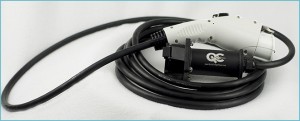 Electric vehicles are good for the environment not just because they decrease petroleum fuel burning, but because the batteries in the vehicles can help support a cleaner grid. To test that concept, BMW signed up drivers of their electric i3 vehicle for a project with Pacific Gas & Electric in the Bay Area. The basic goal was to reduce demand from a fleet of vehicles at a time when the grid was constrained, by activating software in the vehicles to halt charging for up to an hour.
Electric vehicles are good for the environment not just because they decrease petroleum fuel burning, but because the batteries in the vehicles can help support a cleaner grid. To test that concept, BMW signed up drivers of their electric i3 vehicle for a project with Pacific Gas & Electric in the Bay Area. The basic goal was to reduce demand from a fleet of vehicles at a time when the grid was constrained, by activating software in the vehicles to halt charging for up to an hour.
The upside for drivers who participated? They got $1000 for signing up, plus as much as $540, depending on how many days they did not manually opt out of the program. Drivers were notified by a software app when a delay was about to happen and could use it to opt-out if needed.
In practice, that meant eight delays in charging over the 18-month pilot period for the typical driver. However, some vehicles, based on when they were plugged in and how little they opted out, had more delays. Of the 100 participating drivers, for example, three vehicles participated in over 50 events.
If it sounds like a good deal, that’s because it is. In fact, 500 drivers ended up applying for just 100 spots in the pilot. The report did not mention if the payments were cost-effective from a ratepayer standpoint (I suspect not). In other words, could that electricity have been more cheaply supplied or reduced elsewhere? But given that this was a pilot, it was important to get data and participation first.
During the 18 months (from July 2015 to December 2016), PG&E asked BMW 209 times to “provide capacity of 100 kW over an hour-long period.” This is actually a lot of times. As a point of comparison, residential “demand response” (as this kind of moderated demand is called) programs are capped at 15 events per year.
Ultimately, BMW met 90% of the events. The reason for the failings was mostly due to technical problems, which apparently got fixed as the pilot went on. And the response time to actually delay the charging once the utility sent the signal was 2.3 minutes on average, which was fine for the day-ahead market and not bad for the real-time market, which requires 4 minutes at most of delay. The lag was mostly due to communications issues that seemed to get fixed as the pilot unfolded.
Drivers seemed not to mind the delays. The most opt outs for any one event was on Thursday, October 14, 2015 at 11 PM, when three customers opted out. The majority of events had no opt-outs and only two participants opted out for more than two events over the entire pilot. Meanwhile, 95% of the drivers surveyed said that they never, or rarely, had to change driving or charging behaviors. Ultimately, 98% indicated they were satisfied with the experience.
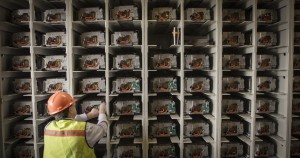 But there was one relatively big hitch to the findings: not enough EV drivers were plugged in at any given moment to meet the demand response events. As a result, BMW had to rely on “second-life” used electric vehicle batteries to meet almost 80% of the power requested during these events. The vehicles on average supplied the other 20% of the demand reduction.
But there was one relatively big hitch to the findings: not enough EV drivers were plugged in at any given moment to meet the demand response events. As a result, BMW had to rely on “second-life” used electric vehicle batteries to meet almost 80% of the power requested during these events. The vehicles on average supplied the other 20% of the demand reduction.
Possibly because of time-of-use rates and cheap off-peak power, many drivers did not plug in until after 9pm. As a result, these drivers simply missed any demand response events happening during the daytime or early evening. In fact, only 37% of the drivers charged at work during the day, due to the lack of availability of chargers at their place of employment.
Meanwhile, the drivers that were able to participate in the top 10%:
[A]re characterized as frequent drivers, who have regular charging patterns and are not on a [time-of-use] rate. These drivers habitually plug in and begin charging around 8 PM in the evening and typically charge for about 3 hours. Since a majority of the events were called from 8–9 PM, these vehicles were frequently called upon and able to participate.
So in the long run, more workplace charging and electricity rates that encourage demand response participation could address these challenges.
Meanwhile, the benefits to the grid look very promising. Each vehicle contributed 4.43 kw of demand response delayed usage. It may not sound like much, but assuming by 2030 the state has 1.2M electric vehicles, with 250,000 drivers enrolled in this kind of program and 17,000 participating in a demand response event:
[T]he potential load drop of a single event in 2030 is about 77.6 MW, which is enough to power approximately 58,000 homes in California. Thus, on a larger scale, a similar program has the potential to provide a significant resource.
So while more work remains to be done, this pilot project is overall very encouraging. Coupled with reforms related to boosting workplace charging and improving electricity rates (the subjects of a forthcoming report from UC Berkeley and UCLA Law), this kind of demand response could be very beneficial for the state.
And it could put a healthy dollop of cash in EV drivers’ wallets to boot.
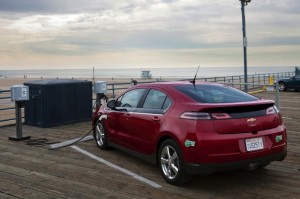 Though the future of electric vehicles remains murky at the federal level, due to Donald Trump’s hostility to climate science and love of oil and gas, the industry will receive a big boost from two companies this holiday season: California electric utilities and Volkswagen.
Though the future of electric vehicles remains murky at the federal level, due to Donald Trump’s hostility to climate science and love of oil and gas, the industry will receive a big boost from two companies this holiday season: California electric utilities and Volkswagen.
Volkswagen has agreed to a partial settlement from its emissions-cheating scandal, which could bring huge dividends to California if it’s enforced properly:
To mitigate environmental harm from their actions, the companies must pay $225 million into a national mitigation fund. California will receive about $41 million of that money for mitigation programs in the state designed to address the additional NOx emissions released by the vehicles in question. This is in addition to $1.2 billion VW is already paying California for mitigation and zero-emission vehicle (ZEV) infrastructure as part of the 2-liter partial consent decree.
The settlement, together with a previous consent decree, also requires the company to fund two “Green Cities” in California, which must have populations of at least 500,000 with many living primarily in disadvantaged communities. These cities will receive “concentrated investment in ZEV programs like car sharing, ZEV transit or freight services and infrastructure and public awareness efforts to support those programs.”
An additional $25 million dollars will support programs such as “replace-and-upgrade programs for high-emitting cars in disadvantaged communities (EFMP Plus-up) and the Clean Vehicle Rebate Project (CVRP), which provide rebates and financial assistance for purchase of ZEVs.”
But perhaps most significantly, California consumers can expect new models of EVs to be fast-tracked:
[T]he manufacturers will provide at least three new models of electric vehicles for sale in California — including at least one SUV model — before 2019. The companies must add a second electric SUV model by 2020 and keep these electric models on the market through at least 2025. ZEV credits generated by placement of these vehicles in California cannot be sold on the ZEV credit market.
All in all, these provisions will definitely provide a major shot in the arm for the industry. As E&E news reports [paywall]:
Analysts say that in the early years of the investment, Volkswagen could nearly double the money spent on construction of EV charging infrastructure, seen as a way to spark more sales. States, cities and private companies are scrambling to get a piece of the Volkswagen pie.
“It’s just so much money,” said Ashley Horvat, vice president of strategic initiatives at PlugShare, an EV charging firm. “It will lay the groundwork for the future, and everybody is waiting to see how they fit into that future.”
Of course, some of the existing charging industry companies are afraid this investment will crowd out competition, while others worry it will allow Volkswagen to gain a monopoly advantage in a new industry — hardly a punitive outcome given the company’s malfeasance.
They also worry it may overshadow recently approved electric utility investment in charging infrastructure. California regulators are finally letting these utilities get into the charging game, as E&E reports:
Last Friday, the California Public Utilities Commission approved a plan by the Pacific Gas and Electric Co. to build 7,500 EV charging stations in its Northern California territory. Ratepayers will shoulder the $130 million cost. It is the third major Californian utility to have an EV charging plan approved, after Southern California Edison and San Diego Gas & Electric.
All in all, states and private companies are (no pun intended) charging ahead with electric vehicles. This momentum may be necessary come January, when the new administration and its oil-and-gas allies in Congress could create some major headwinds for this vital industry.
California regulators have been busy approving “pilot” projects for utilities to start paying for EV charging infrastructure, at significant ratepayer expense. Last week, they approved PG&E’s controversial plan, which had the blessing of environmentalists and unions, while ratepayer advocates and the San Francisco Chronicle cried foul. It will target a deployment of 7,500 level 2 charging ports and 100 DC fast-charging ports.
And with the passage of SB 350 last year, utilities will be entering the EV charging game big time in the coming years. These pilots are just the initial salvo.
But the state had already required $100 million in EV charging investment from NRG/eVgo as part of a legal settlement in 2012. That company has been badly behind schedule on getting these stations up and running, leading regulators to call for an audit over a year ago.
The status of the audit? Well, I emailed the California Public Utilities Commission recently to find out, and they told me they just hired an auditor to do this work at the end of February. No explanation was offered as to why that took the agency a whole year to do so.
So while regulators are busy ushering utilities into the EV charging world, they’re asleep at the wheel monitoring the state’s $100 million investment already in the works. Not a good sign as utilities start spending big ratepayer bucks on EV charging.
Pacific Gas & Electric is raring to go in California to install, operate, and maintain electric vehicle charging infrastructure, at ratepayer expense [PDF]:
PG&E proposes to deploy up to 25,000 level 2 charging stations and 100 DC fast chargers (DCFCs) at workplaces, multi-unit dwellings (MUDs), and at public or retail locations, which will help accelerate EV adoption and attainment of the state’s transportation and clean air goals.
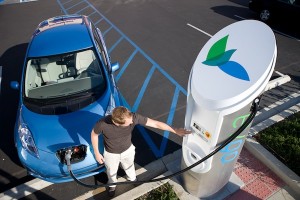 The utility’s effort is now supported by state law, with SB 350 (De Leon, 2015) specifically encouraging Big Utilities to take on Big Oil when it comes to transportation fueling.
The utility’s effort is now supported by state law, with SB 350 (De Leon, 2015) specifically encouraging Big Utilities to take on Big Oil when it comes to transportation fueling.
I’m generally in favor of allowing utilities to enter this space, given the strong and growing need for more infrastructure for the increasing number of plug-in vehicles. But I’m most heartened by this mention in the proposal:
PG&E is currently leading an EPIC-funded [California Energy Commission/Public Utilities Commission] project regarding DCFC [fast-charging] siting in collaboration with UC Davis, E3, and PlugShare. The research findings will develop a public tool to help site DCFC deployments based on forecast traffic demand and lowest utility distribution costs.
The state is long overdue for a better methodology on where to site fast chargers. Current locations are suboptimal, and there are still major corridors in the state that lack adequate chargers for short-range electric vehicle travel (for example, good luck driving your LEAF from San Jose to Monterey).
I’m pleased to see PG&E is part of this grant-funded effort, and hopefully their involvement in EV infrastructure will benefit the state’s EV, environmental, economic and equity goals.
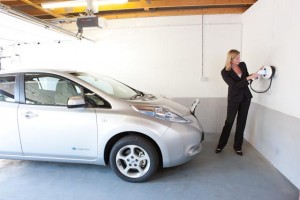 I’ve been an advocate for letting electric utilities build electric vehicle charging stations for a while now. While nobody likes the ideas of regulated monopolies taking over a market, the fact is that private companies are not getting the job done, and there aren’t sufficient charging stations to meet growing demand and to enable longer-distance electric travel.
I’ve been an advocate for letting electric utilities build electric vehicle charging stations for a while now. While nobody likes the ideas of regulated monopolies taking over a market, the fact is that private companies are not getting the job done, and there aren’t sufficient charging stations to meet growing demand and to enable longer-distance electric travel.
So I’ve been following with interest Pacific Gas & Electric’s (PG&E) proposal to serve the 65,000 EV drivers in its Northern California service territory with 25,100 charging stations (the number that may be necessary to meet Governor Brown’s goal of having one million EVs on the road by 2020).
But the California Public Utilities Commission would like to go slower than that, as Charged EVs reports:
[T]he state Public Utilities Commission has put a stop to PG&E’s dreams of empire for the moment, saying that it will need to hold a series of hearings before authorizing the program.
“We must consider the requirement to protect against unfair competition and the demonstrated costs and benefits of any utility electric vehicle charging station proposal,” PUC Commissioner Carla Peterman wrote in her ruling (via San Jose Mercury News). “We find that a more measured approach to utility ownership in PG&E’s service territory is warranted.”
One objection to PG&E’s plan is the cost: $654 million, which the utility plans to pass on to ratepayers. Under the original PG&E proposal, residential electricity customers would pay an additional 70 cents per month on their utility bills from 2018 to 2022.
Peterman also pointed out concerns that control of such a comprehensive network could give PG&E something of a monopoly. The utility’s plan calls for it to have control over the design and support of the charging facilities, something that other companies in the charging industry say could suppress innovation.
I think this approach could make sense. It may be best to go slow on the roll out to see how the market reacts. The CPUC could also ensure that the initial utility stations are located where there is no strong market incentive for private companies to site them. Ideally the state could end up with a hybrid system of some utility-owned stations and some private company-owned ones. The other possibility is that PG&E provides some of the underlying infrastructure for the stations, while charging companies then compete to set up chargers in those locations.
Either way, I imagine this is only the first step on a path to more utility-owned charging stations, and the result will hopefully be better coverage and convenience for EV drivers.
I guess the Bay Area didn’t want to be bested by Kansas City. Now Pacific Gas & Electric, Northern California’s primary investor-owned utility (and the state’s largest) wants to get in on EV charging. As David Baker in the San Francisco Chronicle reports:
PG&E on Monday announced plans to install 25,000 electric car chargers across Northern and Central California, in what the company billed as the nation’s largest charger deployment project yet. The utility, based in San Francisco, described the $653.8 million effort as an important step toward reaching Gov. Jerry Brown’s goal of having 1.5 million zero-emission vehicles on the state’s roads by 2025.
So should all ratepayers have to subsidize these installations, even if they don’t drive EVs? Certainly there’s an argument to be made that everyone benefits from cleaner air and a cleaner grid (from EV batteries used as energy storage). And therefore some level of public investment is justifiable. But it seems to me that part of the equation has to be convenient and accurate pricing and payment mechanisms to cover more of these costs. In California, SB 454 (Corbett, 2014) took a step in this direction by requiring open access to charging stations for those who didn’t sign up for a subscription to a particular charging network.
But ultimately, the charging companies will have to figure out a viable business model, such as the gas station revenue from concessions, that minimizes the need for this kind of public investment. In the meantime, and where such a model just doesn’t work, utility money like this will be necessary to transition all of society to cleaner transportation.


